Perspectives on Our Past
President Franklin D. Roosevelt declared December 7th, 1941, as “a date that will live in infamy.” The Empire of Japan had just drawn the United States into World War II by bombing our military installations at Pearl Harbor in a surprise attack.
A number of Sigma Nu initiates served at Pearl Harbor on December 7th. In this column, I’d like to focus on two brothers who were there that day. These young men, born just a month apart in Southern California, were initiated into Sigma Nu in the 1930s, although at different chapters.
It’s a story of courage and bravery, the willingness to serve and, possibly die, while fighting for a greater cause. Ensigns John Mandeville Emery and Eric Reed Young will always be remembered together in my mind…brothers and shipmates forever.
Eric Reed Young
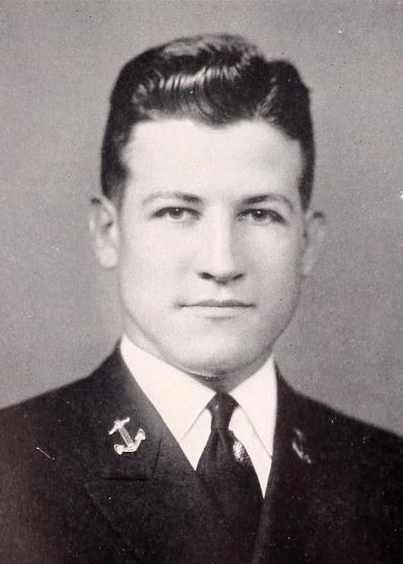
Eric Reed Young was the older of the two. He was born in San Diego, California, on September 6, 1916. His parents, Myrtle L. (Allen) and James Reed Young, were well educated and this had a major impact on Eric’s life. His father, a long-time psychology professor at the University of Nevada, Reno received his Ph.D. from the University of Chicago. Eric’s mother graduated from the University of California, Berkeley and was a member of Phi Beta Kappa.
Although Eric was born in San Diego, his parents soon moved to Reno, Nevada, for a job at the university. Unfortunately, Eric’s mother died suddenly when he was only 15 years old. Despite the loss, Eric graduated from Reno High School in 1934 and immediately enrolled at the University of Nevada, Reno.
Our Delta Xi Chapter (Nevada) pledged Eric in the fall of 1934. He initiated into the chapter as Delta Xi number 251 in 1935. He was an athletic young man and played on the freshmen football and basketball teams his first year. By his second year, he had moved up to the varsity football squad.
Despite his early success at the University of Nevada, Eric must have had a patriotic streak, because he applied to the United States Naval Academy (USNA) at Annapolis. They accepted him into the fall 1936 class of midshipmen. Effectively, this meant he had to attend another four years of college before he could graduate. However, that didn’t deter him one bit.
At the Naval Academy, he continued his athletic exploits. He rowed on the crew team all four years, and also played lacrosse and junior varsity football. He graduated with the class of 1940. In the USNA yearbook, “The Lucky Bag,” his senior entry reads as follows:
“An unfailing sense of humor coupled with an above-the-average mentality have enabled Eric to remain himself in spite of a rigorous academic training. At heart he is still a lad of the “Wild West.” He can be recognized from afar (you’ll hear him before you see him) by his characteristic laugh, which more than once has sent whole theaters into hysterics. Never too busy to refuse help to anyone, Sandy has pulled many a plebe through the intricacies of steam and math. Though he has had a hand in lacrosse and football, crew is his sport. Who knows, you might have to row a battleship home someday, eh, Eric?”
On his graduation date, June 6, 1940, he was officially commissioned as an ensign in the United States Navy.
Naval Career
On June 29, 1940, not long after graduation, he received his first assignment. He was ordered to report to Honolulu, Hawaii, to serve aboard a battleship, the USS Arizona. Before World War II, battleships were the most powerful and important type of warship in the world’s navies. Although their importance would be replaced during and after the war by aircraft carriers, they would remain in use well into the Cold War.
The USS Arizona, commissioned in 1916, was one of the last “super-dreadnought” battleships constructed by the United States. It was one of the ships that escorted President Woodrow Wilson to the Paris Peace Conference at the end of World War I. The ship went through a complete modernization between 1929 and1931. Its armaments included 32 guns, firing shells up to 14” in diameter and weighing up to 1,500 pounds. The guns were capable of hitting a target up to 20 miles away. It also had two torpedo tubes.
As a junior officer, his commanding officer assigned him watch duties aboard the ship. His battle station, in case of attack, was gun turret #1 on the starboard side; the very first gun turret in the bow (front) of the ship.
John Mandeville Emery
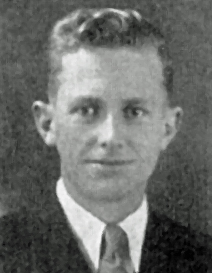
John Mandeville Emery was born on October 9, 1916, just over a month after Eric Young. He was born in Los Angeles to Kathryn and Ralph D. Emery. His father was a salesman, and the family relocated between southern and northern California several times. By the time John was in high school, they lived in Piedmont, California, in the San Francisco Bay area.
John was very active at Piedmont High School. He was the president of Alpha Clan, an organization that raised money for scholarships and other undertakings. He was a member of the Rigma Club whose purpose was to promote good fellowship. He played basketball and was a member of the Bush Rats, a club to further an interest in outdoor life. With an interest in theater, he also acted in several school plays. He graduated from Piedmont High School in 1935 and immediately enrolled at the University of California, Berkeley.
As a freshman, he pledged Sigma Nu in the fall of 1935. On February 15, 1936, our Berkeley chapter initiated him as Beta Psi number 429. He would later serve as the chapter’s Lieutenant Commander. In addition to Sigma Nu, during his four years at Berkeley, he was involved in the Winged Helmut, a junior honor society, and with the Naval ROTC. He was a member of Quarterdeck, the honor society for the Naval ROTC program. His younger brother, Henry, would also pledge and be initiated into our Berkeley chapter.
Upon his graduation in May 1939, he was commissioned in the United States Naval Reserve. He transferred to the US Navy and was commissioned as an ensign in August 1939, as a signal officer, responsible for communications aboard ships. Two months later, he received his first duty station on board the USS Arizona in Honolulu.
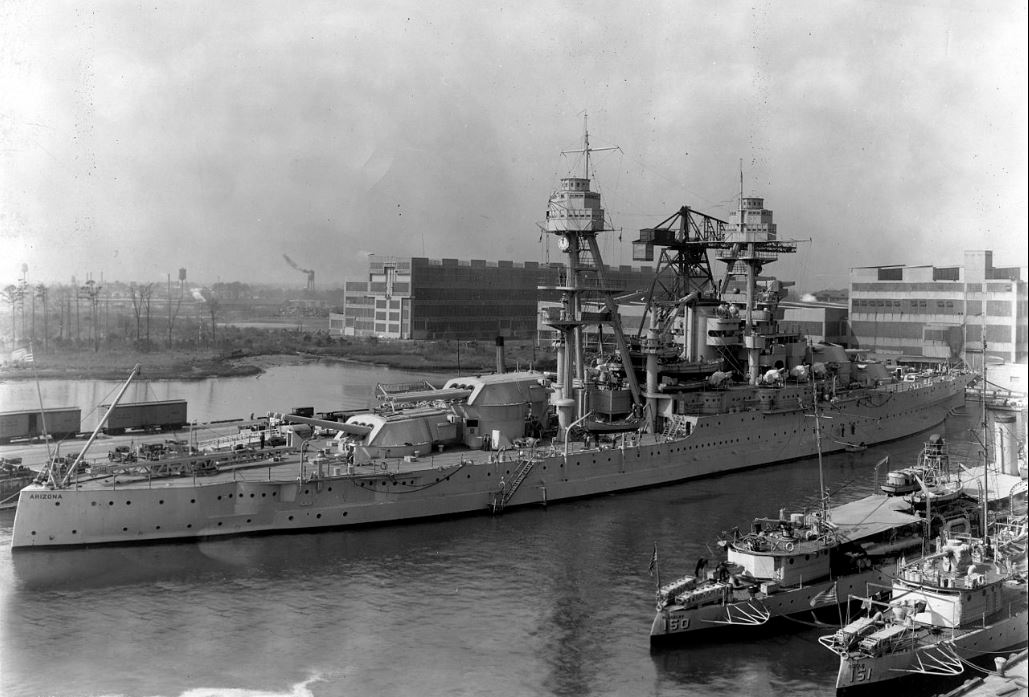
USS Arizona
December 1941
By December 1941, Ensign Emery had served on board the USS Arizona for over two years; Ensign Young for almost a year and a half. With a maximum crew of 2,290 men, it’s hard to say whether they knew each other during that time. However, since both held the rank of Ensign and were officers, it’s very likely they did.
No one at the beginning of December 1941 thought war would come to Hawaii. The United States was still at peace, and everyday life continued for the men and women living there. In a letter Ensign Young wrote to his sister around Thanksgiving, he reported that everything seemed serene in Hawaii.
All that serenity changed on the morning of Sunday, December 7th. Reveille sounded at 7:00 am that morning on the USS Arizona, and preparations were underway for church services on the stern of the ship. Since the ship had just returned from training exercises the previous week, the men were likely allowed to sleep in a little. However, as officers and role models, Ensigns Emery and Young would probably have arisen at reveille.
Less than an hour later, shortly before 8:00, Japanese planes from six carriers would strike the U.S. Pacific Fleet. At 7:55 am, air raid alarms on the ship went off alerting all men to report immediately to their assigned battle stations. In Ensign Young’s case, this meant gun turret #1 at the front of the ship. Ensign Emery, as a signal officer would have rushed to the signal bridge.
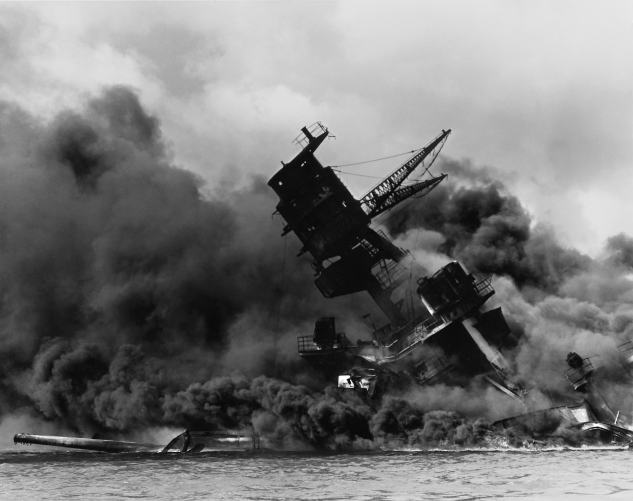
Engulfed in flames, the USS Arizona begins to list and sink into Pearl Harbor.
Shortly after 8:00 am, the bombers started attacking the battleships, including the Arizona. At least four bombs hit the ship, but the critical one struck at approximately 8:06 am. It was an armor-piercing bomb and struck in the vicinity of gun turret #2 in the front of the ship. It pierced through four armor-plated decks of the ship until it hit the forward magazine. Seven seconds after it first struck, the magazine went up in a cataclysmic explosion of flame and smoke. That explosion destroyed much of the interior structure of the forward part of the ship. It caused the forward gun turrets and conning tower to collapse into the interior of the ship and the foremast and funnel to collapse forward, effectively cutting the ship into two. The explosion started a fire on board that enveloped over two-thirds of the ship and would continue burning for two days.
The forward gun turrets which were above the forward magazine were destroyed, including the gun turret where Ensign Young likely was. None of the crewmen in the forward gun turrets survived, and all would likely have died instantly from the explosion.
Since Ensign Emery’s battle station was on the signal bridge, he was likely killed as an after effect of the explosion when the foremast and funnel collapsed forward into the destroyed part of the front of the ship.
The attack and sinking of the USS Arizona resulted in the loss of 1,177 men of the 1,512 crewmen (78%) on board at the time. The men killed on the Arizona represented almost half of all the men killed at Pearl Harbor that day. Rescue crews were able to remove some of the bodies afterward, but over 900 still remain in the sunken ship.
Thurston Clarke in his book, Pearl Harbor Ghosts, puts the loss on the USS Arizona in perspective:
…in 1941, when the United States was at peace, to lose over a thousand sailors in seconds, on a single battleship and to a single bomb, was an unprecedented catastrophe. It represented more sailors than had been lost in action in the Spanish-American War and World War I combined, the most lost in the sinking of a single vessel in U.S. naval history, and the greatest number of human beings killed in a single explosion in the history of warfare, a record broken only by Hiroshima.”
Awards
Posthumously, the military awarded both men the following medals:
- Purple Heart
- American Defense Service Medal with Fleet Clasp
- Asiatic-Pacific Campaign Medal with Star
- World War II Victory Medal
In addition, the destroyer escort ship, USS Emery, was named after Ensign Emery. Commissioned by the US Navy on August 14, 1943, it served during the remainder of World War II in the Pacific to protect convoys and other ships from Japanese submarines and aircraft. During that time, the ship earned four battle stars.
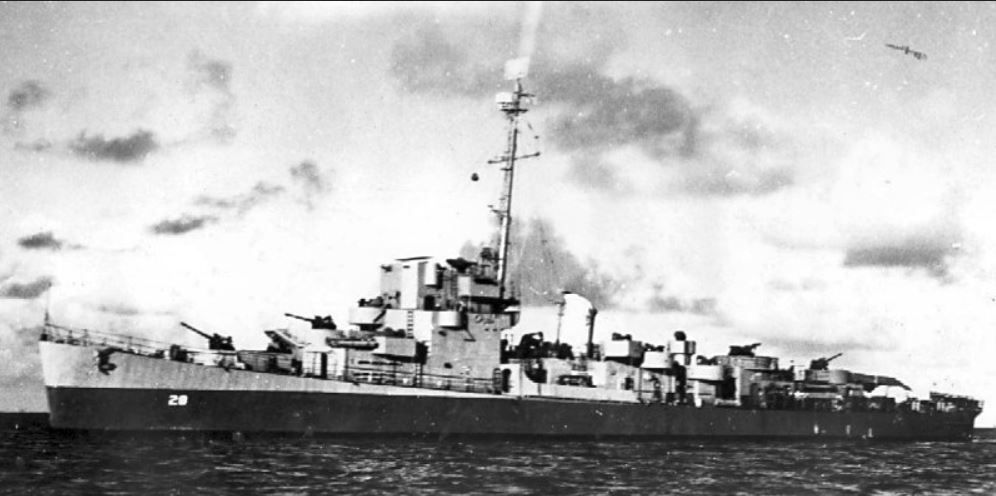
The destroyer escort USS Emery.
Ensigns Emery and Young were among the first U.S. casualties of World War II. Neither of these men had to be drafted into the military. Both of them signed up for military duty because they believed in protecting our country and way of life. Although they never expected to die, both were willing to take the risk for what they were taught and believed. Both men are among those still entombed in the USS Arizona to this day…brothers and shipmates forever.
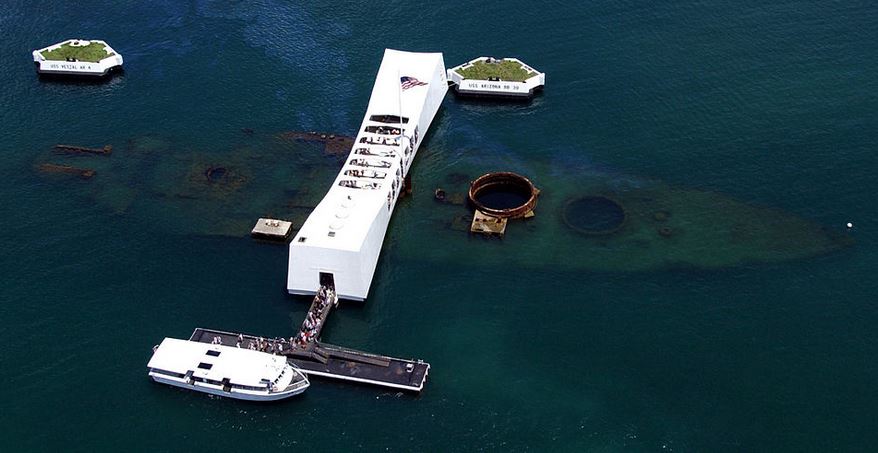
The USS Arizona Memorial.